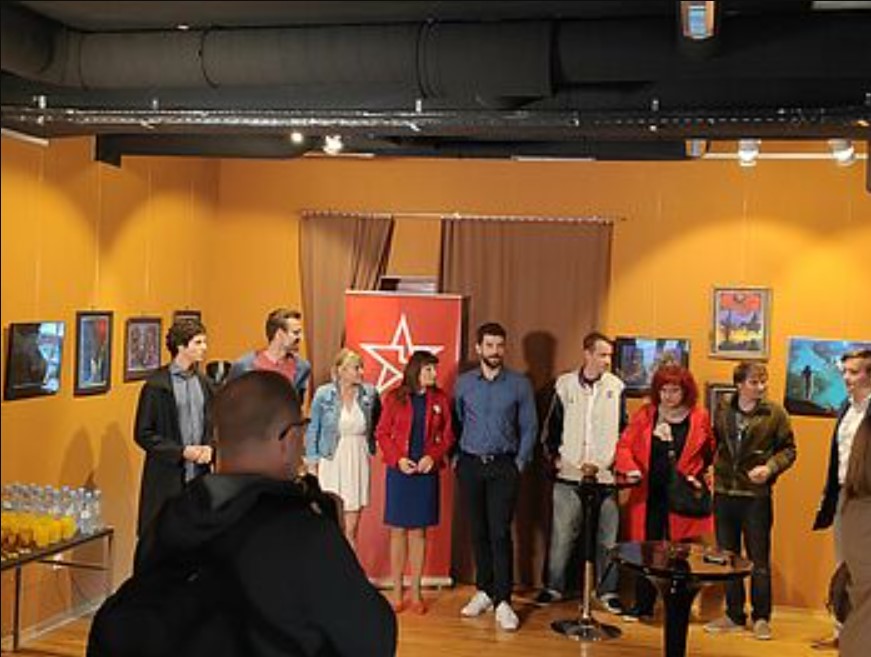On Sunday, 26th of May, Slovenia voted for its MEPs for the fourth time since they became the first former Yugoslav Republic to join the EU on 1st of May 2004. At the same time, this is the second time that a contestant in the elections was a party which is a member of the Party of the European Left.
This time, frontrunner of the Levica’s (The Left; in 2014 ran as an electoral alliance under the name Združena Levica, The United Left) candidacy Violeta Tomić was also the Spitzenkandidatin of the EL on the EU level. In Slovenian elections, voters could have cast their votes both for party lists and preferentially for one of the candidates on the list they are voting for.
The Results
Number of voters who went out to the polls is the highest in the history of Slovenian EP elections with 482.761, which is similar to elections in 2009 and 2004. Nevertheless, although the turnout was highest ever, it is still standing at weak 28,32%. Results also did not fall far from the expected as a coalition of EPP affiliates Slovenska demokratska stranka (SDS – Slovenian Democratic Party), led by Janez Janša – one of closest foreign alliesof Viktor Orban – and Slovenska ljudska stranka (SLS – Slovenian People’s Party) won the highest share of votes (26,25%), or 3 out of eight Slovenian MEPs. Levica won 6,43% which was fifth best result (out of 14 candidacies) but not enough for an MEP. Among other results before the elections it was clear that a contest will occur between senior governing party Lista Marjana Šarca (Marjan Šarec List – LMŠ; ALDE affiliate) and junior government partner Socialni demokrati (SD – Social Democrats; PES affiliate), on whether voters will affirm LMŠ’s seniority or reward SD’s long standing MEP Tanja Fajon. SD won 18,66% and LMŠ won 15,44%, which translates to two MEPs each. The last of eight Slovenian MEPs was won by Christian Democrats (NSi; EPP affiliate), who won 11,12% of the popular vote.
In the 2014 elections EPP members won five out of eight Slovenian MEPs. Three were won by Janša’s SDS with support of 24.78% or 99.643 voters, while other two were won by an electoral alliance of Nova Slovenija (Nsi – New Slovenia) and SLS with support of 16.6% or 66.760 voters. Remaining three mandates went to Igor Šoltes, now a DeSUS candidate then a Green candidate with support of 10.33%, then to DeSUS (ALDE) who won 8.12% and, final one, to SD who won 8.08% of the vote.
Coalition Government of Five Parties (With Support of The Left)
Slovenia came to these elections few weeks short of a year since the parliamentary elections after which a coalition government of liberals (Lista Marjana Šarca, Stranka Mira Cerara, Stranka Alenke Bratušek) social democrats (Socialni demokrati) and pensioners’ (DeSUS) with the programme support of Levica was assembled under the premiership of Marjan Šarec. Those elections led to an unprecedented diversity in the Slovenian Parliament (Državni zbor), bringing nine parties into a 90 members chamber. A coalition government formed out of five parties with the support of the sixth one was also needed to exclude from government Janša’s SDS.
Levica’s programme support for Šarec’s government resulted in passing the bill on minimum wage which will raise it above the, so called, psychological barrier of 700 €, and in later stages transform it towards a living wage, linking minimum wage amount to living costs. Indexing the minimum wage at the level of 20% above costs of living was also a demand of European Left advocated for by Tomić as its Spitzenkandidatin.
Elections Campaigns
Election campaign, which effectively lasted for a month, was mostly devoid of serious political content and disconnected from discussing the issues pertinent to the present and possible futures of the European Union. It is something that makes Slovenia comparable to other former socialist member states. It is questionable to what extent are those states integrated into European politics, and to what extent do the voters in those states self-understand themselves as European voters.
In that context, Levica continued to advocate its consequently international politics in this campaign. Their manifesto, whose title translates to English as For the Europe of its People, not of Capital (Za Evropo ljudi, ne kapitala) is another – after ones for parliamentary and municipal elections in Slovenia – well thought set of measures for the ecosocialist transformation. Tackling issues of democratic deficit, uneven development, climate crisis and unemployment, Levica has demonstrated how it is possible to offer practical solutions to the most important problems that Europeans face, nevermind if they are living in the central or peripheral European states.
Although their election manifesto offered progressive reforms listed and explained on around 50 pages of text, Levica did not manage to impose it onto public discussion. Of the rare moments when Levica was leading the discussion was that when Violeta Tomić expressed her understanding for parents sceptical of obligatory vaccination plan, which was then spinned to denounce this party as succumbing to anti-vaxx hysteria, however that is not factually correct.
With public disinterest on one hand, and usual lack of imagination of the mainstream parties on the other, even when the campaign had political content, that content was centered on politics of migrations and security policy of the Union. Dominance of those topics went hand in hand with plans of the right-wing to wage a fear mongering campaign directed towards migrants and imagined danger of loss of European identity. Besides that, campaign also figured as a populist contest between lead candidates of contesting parties, where Levica candidates were bound to lose. In that contest Violeta Tomić ended up tenth by the number of preferential votes. Highest numbers of preferential votes were won by incumbent social-democrat MEP Tanja Fajon, followed by ex-TV presenter Irena Joveva, who was lead candidate of prime ministers party and conservative Romana Tomc. Thesis of these elections as popularity contest is supported by the fact that incumbent MEPs Igor Šoltes (DeSUS) and Angelika Mlinar (Stranka Alenke Bratušek; in 2014 elected as a MEP from Austria) won more preferential votes than Tomić, although their parties won less votes than Levica.
When we evaluated and analysed Levica’s performance in Slovenia’s parliamentary elections of 2018, it was said that the party would face challenges of pushing its manifesto agenda into parliamentary procedure and broader political arena, and, furthermore, of assembling a broader extra parliamentary coalition of civil society actors to push democratic socialist agenda on a broader social plan.
These elections have shown that the party has enough and adequate capacities to identify political issues which which to address so that socialist transformation would be undertaken, and to articulate its political stance, as well as political measures to achieve so. It is worth noting that its election manifesto is, in former socialist states, a rare example of elaborate Marxist-informed agenda of tackling both democratic deficit of European institutions and climate crisis, leading towards a socially just, democratic and sustainable society.
Nevertheless, the fact that Levica, in terms of percentage, lost around three percent of the vote and won around 50.000 votes less than in parliamentary elections of 2018 — in which, truth be told, voted 420.000 voters more than in these European elections — impose the task of discussing reasons of lack of popular suport for Levica’s programme, under the supposition that socialist politics is impossible without democratic organising of the working class.
Cover photo: Levica in election night



